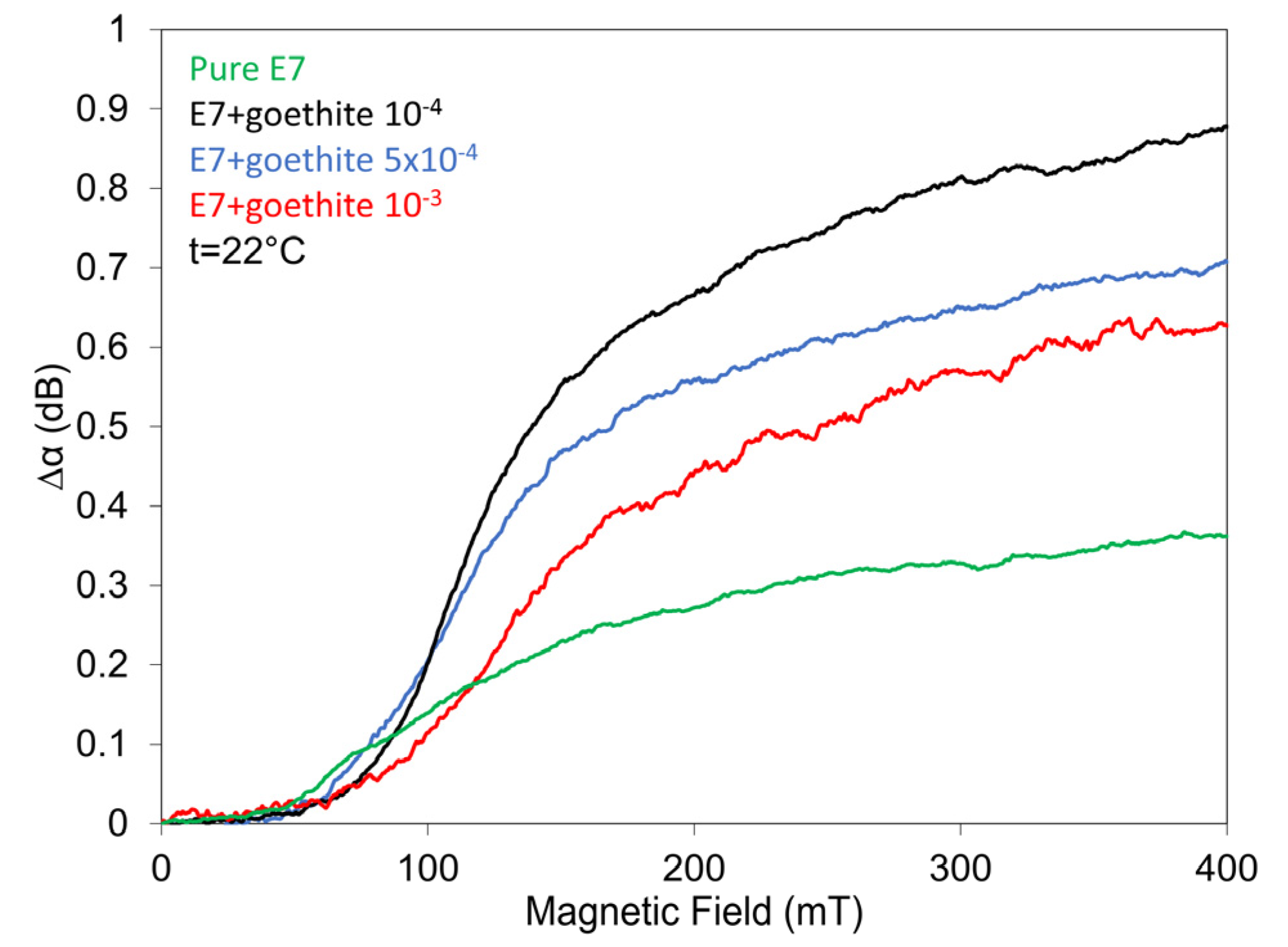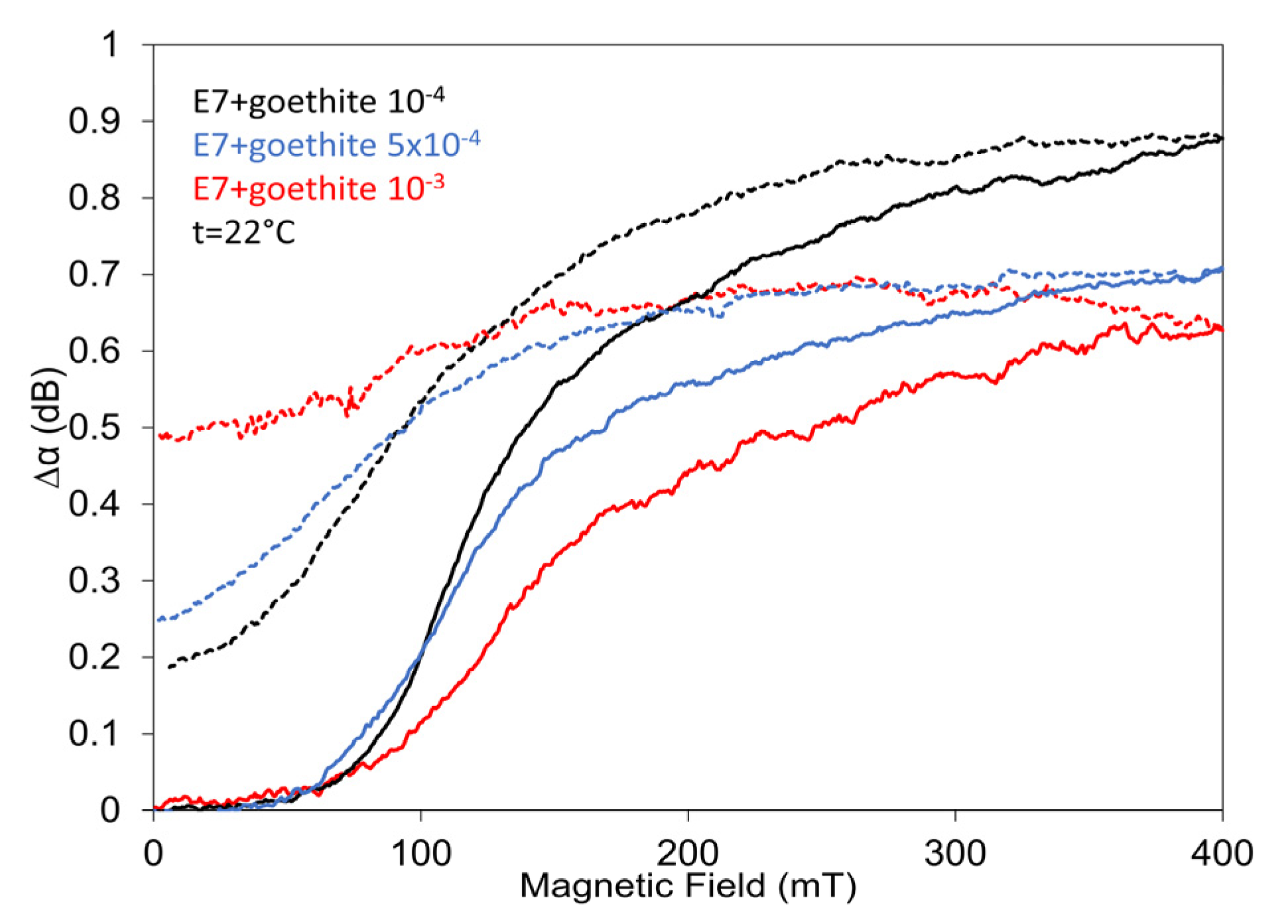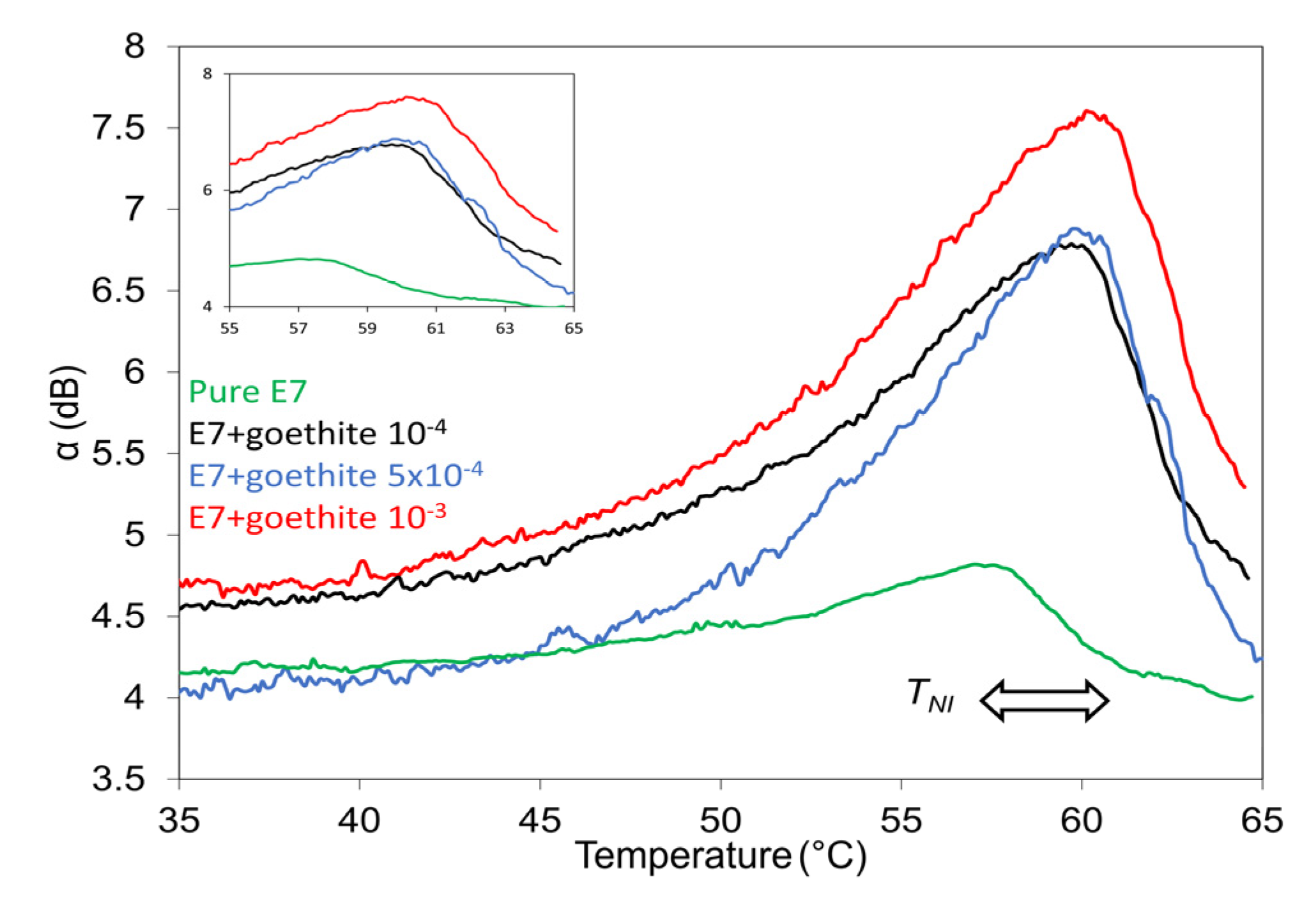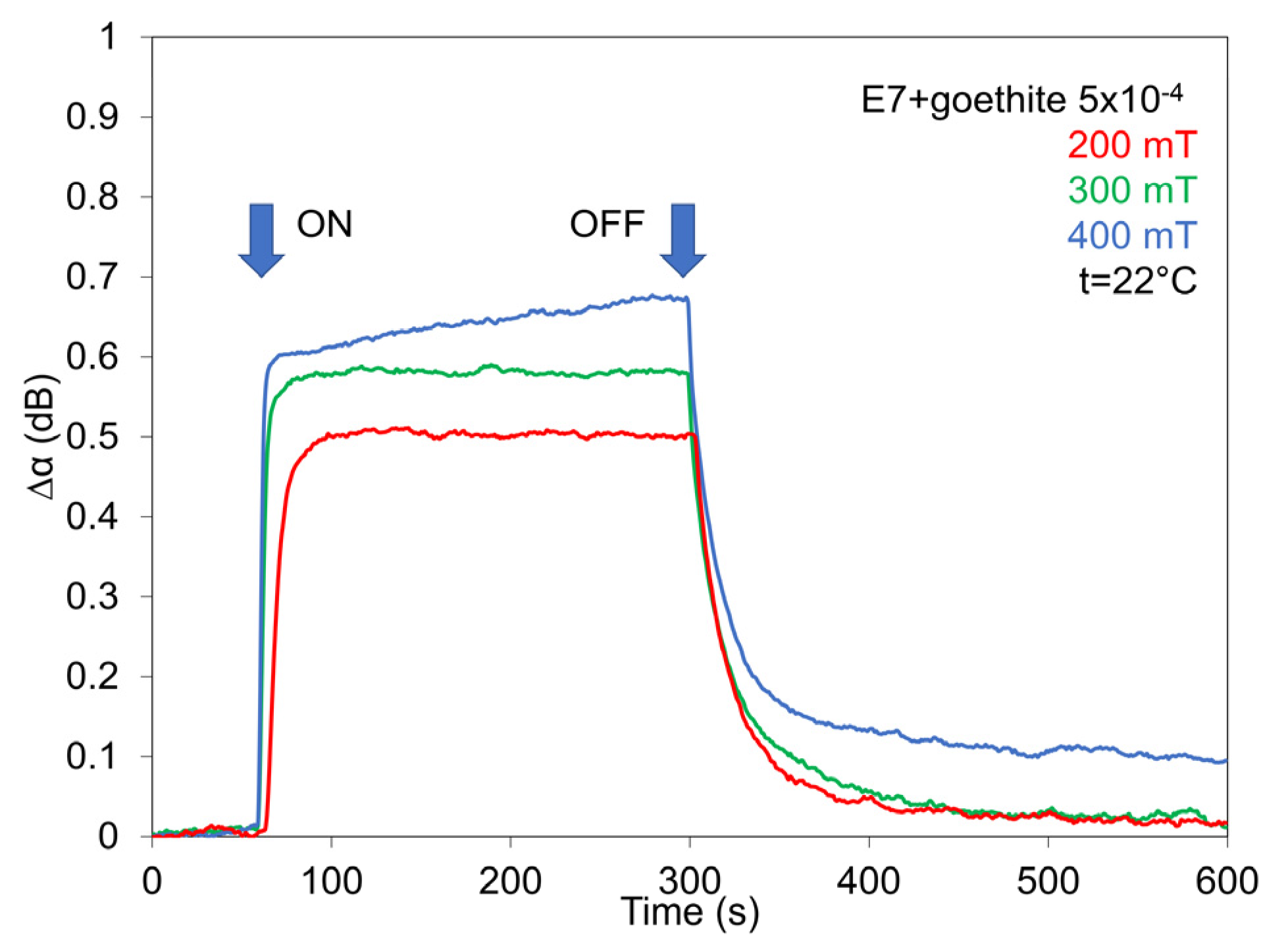Influence of Goethite Nanorods on Structural Changes and Transitions in Nematic Liquid Crystal E7
Abstract
1. Introduction
2. Experiment
2.1. Materials
2.2. SAW Measurements
2.3. Light Transmission Measurements
3. Results
3.1. SAW Results
3.2. Light Transmission Investigation
4. Conclusions
Author Contributions
Funding
Data Availability Statement
Conflicts of Interest
References
- Lagerwall, J.P.; Scalia, G. Liquid Crystals with Nano and Microparticles, Vol. I; Word Scientific: Singapore, 2017. [Google Scholar]
- Hegmann, T.; Qi, H.; Marx, V.M. Nano in liquid crystals:synthesis, self-assembly, defect formation and potential applications. J. Inorg. Organomet. Polym. Mater. 2007, 17, 483. [Google Scholar] [CrossRef]
- Brochard, F.; de Gennes, P.G. Theory of magnetic suspensions in liquid crystals. J. Phys. 1970, 31, 691. [Google Scholar] [CrossRef]
- Davidson, P.; Batail, P.; Gabriel, J.C.P.; Livage, J.; Sanchez, C.; Bourgaux, C. Mineral liquid crystalline polymers. Prog. Polym. Sci. 1997, 22, 91. [Google Scholar] [CrossRef]
- Zhang, G.; Wang, S.; Yang, F. Efficient Adsorption and Combined Heterogeneous/Homogeneous Fenton Oxidation of Amaranth Using Supported Nano-FeOOH As Cathodic Catalysts. J. Phys. Chem. C. 2012, 116, 3623. [Google Scholar] [CrossRef]
- Adhyapak, P.V.; Mulik, U.P.; Amalnerkar, D.P.; Mulla, I.S. Low Temperature Synthesis of Needle-like α-FeOOH and Their Conversion into α-Fe2O3 Nanorods for Humidity Sensing Application. J. Am. Ceram. Soc. 2013, 96, 731. [Google Scholar] [CrossRef]
- Wang, J.; Li, L.; Wong, C.L.; Sun, L.; Shen, Z.; Madhavi, S. Controlled synthesis of α-FeOOH nanorods and their transformation to mesoporous α-Fe2O3, Fe3O4@C nanorods as anodes for lithium ion batteries. RSC Adv. 2013, 3, 15316. [Google Scholar] [CrossRef]
- Lemaire, B.J.; Davidson, P.; Petermann, D.; Panine, P.; Dozov, I.; Stoenescu, D.; Jolivet, J.P. Physical properties of aqueous suspensions of goethite (αα-FeOOH) nanorods. Eur. Phys. J. E Soft Matter Biol. Phys. 2004, 13, 309. [Google Scholar] [CrossRef]
- Van den Pol, E.; Verhoeff, A.A.; Lupascu, A.; Diaconeasa, M.A.; Davidson, P.; Dozov, I.; Kuipers, B.W.; Thies-Weesie, D.M.; Vroege, G.J. Magnetic-field-induced nematic–nematic phase separation and droplet formation in colloidal goethite. J. Phys. Condens. Matter 2011, 23, 194108. [Google Scholar] [CrossRef]
- Gorkunov, M.V.; Osipov, M.A. Mean-field theory of a nematic liquid crystal doped with anisotropic nano. Soft Matter 2011, 7, 4348–4356. [Google Scholar] [CrossRef]
- Gdovinova, V.; Tomašovicová, N.; Éber, N.; Tóth-Katona, T.; Závišová, V.; Timko, M.; Kopčanský, P. Influence of the anisometry of magnetic nanoparticles on the isotropic-nematic phase transition. Liq. Cryst. 2014, 41, 1773–1777. [Google Scholar] [CrossRef]
- Bury, P.; Veveričík, M.; Černobila, F.; Kopčanský, P.; Timko, M.; Závišová, V. Study of Structural Changes in Nematic Liquid Crystals Doped with Magnetic Nano Using Surface Acoustic Waves. Crystals 2020, 10, 1023. [Google Scholar] [CrossRef]
- Häsler, M.; Nadasi, H.; Feneberg, M.; Marino, S.; Giesselmann, F.; Behrens, S.; Eremin, A. Magnetic tilting in nematic liquid crystals driven by self-assembly, Adv. Funct. Mater. 2021, 31, 2101847. [Google Scholar] [CrossRef]
- Kopčanský, P.; Tomašovičová, N.; Timko, M.; Závišová, V.; Tomčo, L.; Jadzyn, J. The Sensitivity of Ferronematics to External Magnetic Fields. J. Phys. Conf. Ser. 2010, 200, 072055. [Google Scholar] [CrossRef]
- Bury, P.; Kúdelčík, J.; Hardoň, Š.; Veveričík, M.; Kopčanský, P.; Timko, M.; Závišová, V. Effect of spherical magnetic particles on liquid crystals behavior studied by surface acoustic waves. J. Magn. Magn. Mater. 2017, 423, 57–60. [Google Scholar] [CrossRef]
- Hakobyan, M.R.; Hakobyan, R.S. Lowering of the magnetic Fréedericksz transition threshold in nematic liquid crystals doped with ferromagnetic nano. J. Contemp. Phys. 2011, 46, 116–118. [Google Scholar] [CrossRef]
- Zakuťanská, K.; Lacková, V.; Tomašovičová, N.; Burylov, S.; Burylova, N.; Skosar, V.; Juríková, A.; Vojtko, M.; Jadzyn, J.; Kopčanský, P. Nanoparticle’s size, surfactant and concentration effects on stability and isotropic-nematic transition in ferronematic liquid crystal. J. Mol. Liq. 2019, 289, 111125. [Google Scholar] [CrossRef]
- Bury, P.; Veveričík, M.; Černobila, F.; Molčan, M.; Zakuťanská, K.; Kopčanský, P.; Timko, M. Effect of Liquid Crystalline Host on Structural Changes in Magnetosomes Based Ferronematics. J. Nanomater. 2021, 11, 2643. [Google Scholar] [CrossRef] [PubMed]
- Kopčanský, P.; Gdovinová, V.; Burylov, S.; Burylova, N.; Voroshilov, A.; Majorošová, J.; Agresti, F.; Zin, V.; Barison, S.; Jadzyn, J.; et al. The influence of goethite nanorods on structural transitions in liquid crystal 6CHBT. J. Magn. Magn. Mater. 2018, 459, 26–32. [Google Scholar] [CrossRef]
- Mouquinho, A.; Saavedra, M.; Maiau, A.; Petrova, K.; Barros, M.T.; Figueirinhas, J.L.; Sotomayor, J. Films Based on New Methacrylate Monomers: Synthesis, Characterization and Electro-Optical Properties. Mol. Cryst. Liq. Cryst. 2011, 542, 132–140. [Google Scholar] [CrossRef]
- Bury, P.; Veveričík, M.; Kopčanský, P.; Timko, M.; Lacková, V. Structural changes in liquid crystals doped with spindle magnetic particles. Phys. E Low-dimensional Syst. Nanostructures 2021, 134, 114860. [Google Scholar] [CrossRef]
- Bury, P.; Veveričík, M.; Kopčanský, P.; Timko, M.; Závišová, V. Effect of spherical, rod-like and chain-like magnetic nanoparticles on magneto-optical response of nematics. Acta Phys. Pol. A 2019, 36, 101–106. [Google Scholar] [CrossRef]
- Bury, P.; Veveričík, M.; Černobila, F.; Tomašovičová, N.; Zakuanská, K.; Kopčanský, P.; Timko, M.; Jarošová, M. Role of magnetic nanoparticles size and concentration on structural changes and corresponding magneto-optical behavior of nematic liquid crystals. J. Nanomater. 2022, 12, 2463. [Google Scholar] [CrossRef] [PubMed]
- Mertelj, A.; Lisjak, D. Ferromagnetic nematic liquid crystals. Liq. Cryst. Rev. 2017, 5, 1–33. [Google Scholar] [CrossRef]
- Bury, P.; Veveričík, M.; Kopčanský, P.; Timko, M.; Mitróová, Z. Structural Changes in Liquid Crystals Doped with Functionalized Carbon Nanotubes, Phys. E 2018, 103, 53–59. [Google Scholar] [CrossRef]
- Dzarova, A.; Royer, F.; Timko, M.; Jamon, D.; Kopčanský, P.; Kovac, J.; Choueikani, F.; Gojzewski, H.; Rousseau, J.-J. Magneto-optical study of magnetite nanoparticles prepared by chemical and biomineralization process. J. Magn. Magn. Mater. 2011, 323, 1453–1459. [Google Scholar] [CrossRef]
- Balcerzak, A. Ultrasonic measurement in the 1-(trans-4-hexylcyclohexyl)-4-isothiocyanatobenzene near the nematic-isotropic transition. Arch. Acoust. 2005, 30, 373–378. [Google Scholar]
- Wu, S.T. Design of a liquid crystal based tunable electrooptic filter. Appl. Opt. 1989, 28, 48–52. [Google Scholar] [CrossRef] [PubMed]
- Abbasov, M.E.; Carlisle, G.O. Effect of carbon nanotubes on electro-optical properties od dye-doped nematic liquid crystal. J. Mater. Electron. 2012, 23, 712–717. [Google Scholar] [CrossRef]
- Prshin, A.M.; Gunyakov, V.A.; Zyryanov, V.Y.; Shabanov, V.F. Electric and Magnetic Field-Assisted Orientational Transitions in the ensembles of Domains in a Nematic Liquid Crystal on the Polymer Surface. Int. J. Mol. Sci. 2014, 15, 17838–17851. [Google Scholar] [CrossRef]
- Zakuťanská, K.; Petrov, D.; Kopčanský, P.; Wegłowska, D.; Tomašovičová, N. Fréedericksz Transitions in 6CB Based Ferronematics—Effect of Magnetic Nanoparticles Size and Concentration. Materials 2021, 14, 3096. [Google Scholar] [CrossRef]
- Burylov, S.V.; Raikher, Y.L. Magnetic Fredericksz transition in a ferronematic. J. Magn. Magn. Mater. 1993, 122, 62–66. [Google Scholar] [CrossRef]
- Porov, P.; Chandel, V.S. Carbon nanotube doped liguid crystals. J. Sci. Arts 2016, 16, 249–264. [Google Scholar]
- Zakhlevnykh, A.N.; Petrov, D.A. Magnetic field induced orientational transitions in soft compensated ferronematics. Phase Transit. 2014, 87, 1–18. [Google Scholar] [CrossRef]
- Chen, S.-H.; Amer, N.M. Observation of Macroscopic Collective Behavior and New Texture in Magnetically Doped Liquid Crystals. Phys. Rev. Lett. 1983, 51, 2298–2301. [Google Scholar] [CrossRef]






Disclaimer/Publisher’s Note: The statements, opinions and data contained in all publications are solely those of the individual author(s) and contributor(s) and not of MDPI and/or the editor(s). MDPI and/or the editor(s) disclaim responsibility for any injury to people or property resulting from any ideas, methods, instructions or products referred to in the content. |
© 2023 by the authors. Licensee MDPI, Basel, Switzerland. This article is an open access article distributed under the terms and conditions of the Creative Commons Attribution (CC BY) license (https://creativecommons.org/licenses/by/4.0/).
Share and Cite
Bury, P.; Veveričík, M.; Černobila, F.; Tomašovičová, N.; Timko, M.; Kopčanský, P.; Agresti, F.; Barison, S. Influence of Goethite Nanorods on Structural Changes and Transitions in Nematic Liquid Crystal E7. Crystals 2023, 13, 162. https://doi.org/10.3390/cryst13020162
Bury P, Veveričík M, Černobila F, Tomašovičová N, Timko M, Kopčanský P, Agresti F, Barison S. Influence of Goethite Nanorods on Structural Changes and Transitions in Nematic Liquid Crystal E7. Crystals. 2023; 13(2):162. https://doi.org/10.3390/cryst13020162
Chicago/Turabian StyleBury, Peter, Marek Veveričík, František Černobila, Natália Tomašovičová, Milan Timko, Peter Kopčanský, Filippo Agresti, and Simona Barison. 2023. "Influence of Goethite Nanorods on Structural Changes and Transitions in Nematic Liquid Crystal E7" Crystals 13, no. 2: 162. https://doi.org/10.3390/cryst13020162
APA StyleBury, P., Veveričík, M., Černobila, F., Tomašovičová, N., Timko, M., Kopčanský, P., Agresti, F., & Barison, S. (2023). Influence of Goethite Nanorods on Structural Changes and Transitions in Nematic Liquid Crystal E7. Crystals, 13(2), 162. https://doi.org/10.3390/cryst13020162






